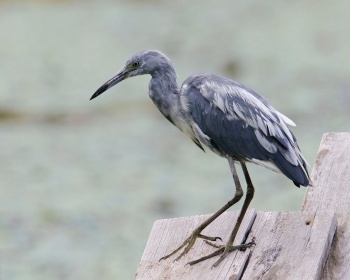(range, ref) |
(Imp size. Picture of 2nd year bird. Some extra info. References updated) |
||
| Line 2: | Line 2: | ||
;[[:Category:Egretta|Egretta]] caerulea | ;[[:Category:Egretta|Egretta]] caerulea | ||
==Identification== | ==Identification== | ||
| − | Height | + | Height 51–76 cm (20-30 in)<br/> |
Ws. 102 cm<br/> | Ws. 102 cm<br/> | ||
Weight 325 g | Weight 325 g | ||
| Line 8: | Line 8: | ||
Sexes similar | Sexes similar | ||
====Breeding Adult==== | ====Breeding Adult==== | ||
| + | [[Image:Little blue heron 2.jpg|thumb|350px|right|Juvenile<br /> Photo by {{user|bobsofpa|bobsofpa}}]] | ||
*Blue-grey body | *Blue-grey body | ||
*Purplish head and neck | *Purplish head and neck | ||
| Line 13: | Line 14: | ||
*Dark blue legs and feet | *Dark blue legs and feet | ||
====Non-breeding Adult==== | ====Non-breeding Adult==== | ||
| − | + | ||
*Dark blue head and neck | *Dark blue head and neck | ||
*Paler legs | *Paler legs | ||
| Line 22: | Line 23: | ||
Gradually acquire blue plumage as they mature. | Gradually acquire blue plumage as they mature. | ||
==Distribution== | ==Distribution== | ||
| + | [[Image:Image1546.jpg|thumb|350px|right|Second year<br />Photo by {{user|Kadawe|Kadawe}}<br />Gloucester, [[Massachusetts]], July 2016]] | ||
Found along east coast north to [[Massachusetts]], along the Mississippi north to Missouri, and to about 15o miles north of the Gulf Coast. Regularly found 300 miles north of breeding range. Rare vagrant north of that. | Found along east coast north to [[Massachusetts]], along the Mississippi north to Missouri, and to about 15o miles north of the Gulf Coast. Regularly found 300 miles north of breeding range. Rare vagrant north of that. | ||
| Line 27: | Line 29: | ||
Northern birds migrate south to winter in [[Florida]], the [[West Indies]] and [[South America]]. | Northern birds migrate south to winter in [[Florida]], the [[West Indies]] and [[South America]]. | ||
| − | + | ||
==Taxonomy== | ==Taxonomy== | ||
| − | + | This is a [[Dictionary_M-S#M|monotypic]] species<sup>[[#References|[1]]]</sup>. | |
==Habitat== | ==Habitat== | ||
Swamps, flooded grasslands and lagoons, also coastal habitats in some areas. | Swamps, flooded grasslands and lagoons, also coastal habitats in some areas. | ||
==Behaviour== | ==Behaviour== | ||
| + | [[Image:Little Blue Heron4.JPG|thumb|350px|right|Photo by {{user|bhowdy|bhowdy}}<br />[[Harris Neck National Wildlife Refuge]], South Newport, [[Georgia]], [[USA]], June 2008]] | ||
====Breeding==== | ====Breeding==== | ||
| − | + | They nest in colonies, often with other herons, usually on platforms of sticks in trees or shrubs. The clutch consists of 3-7 light blue eggs. | |
====Diet==== | ====Diet==== | ||
| − | + | Their diet consists of slow moving, bottom feeding shellfish, crustaceans and insects such as dragonflies. | |
==References== | ==References== | ||
| − | #{{Ref- | + | #{{Ref-Clements6thAug15}}#Handbook of the Birds of the World Alive (retrieved August 2016) |
| + | #Wikipedia | ||
#BF Member observations | #BF Member observations | ||
# Alvaro Jaramillo. 2003. Birds of Chile. Princeton Field Guides. ISBN 0-691-11740-3 | # Alvaro Jaramillo. 2003. Birds of Chile. Princeton Field Guides. ISBN 0-691-11740-3 | ||
Revision as of 23:58, 1 August 2016
- Egretta caerulea
Identification
Height 51–76 cm (20-30 in)
Ws. 102 cm
Weight 325 g
Sexes similar
Breeding Adult
- Blue-grey body
- Purplish head and neck
- Long blue plumes
- Dark blue legs and feet
Non-breeding Adult
- Dark blue head and neck
- Paler legs
Immature
- All white except for dark wing tips and have
- Yellowish legs
Gradually acquire blue plumage as they mature.
Distribution
Found along east coast north to Massachusetts, along the Mississippi north to Missouri, and to about 15o miles north of the Gulf Coast. Regularly found 300 miles north of breeding range. Rare vagrant north of that.
Occurs throughout the West Indies and in Mexico breeds on both coasts and south to Panama. In South America ranges south to northern Chile in the west and Uruguay in the east.
Northern birds migrate south to winter in Florida, the West Indies and South America.
Taxonomy
This is a monotypic species[1].
Habitat
Swamps, flooded grasslands and lagoons, also coastal habitats in some areas.
Behaviour
Breeding
They nest in colonies, often with other herons, usually on platforms of sticks in trees or shrubs. The clutch consists of 3-7 light blue eggs.
Diet
Their diet consists of slow moving, bottom feeding shellfish, crustaceans and insects such as dragonflies.
References
- Clements, J. F., T. S. Schulenberg, M. J. Iliff, D. Roberson, T. A. Fredericks, B. L. Sullivan, and C. L. Wood. 2015. The eBird/Clements checklist of birds of the world: v2015, with updates to August 2015. Downloaded from http://www.birds.cornell.edu/clementschecklist/download/
- Handbook of the Birds of the World Alive (retrieved August 2016)
- Wikipedia
- BF Member observations
- Alvaro Jaramillo. 2003. Birds of Chile. Princeton Field Guides. ISBN 0-691-11740-3
Recommended Citation
- BirdForum Opus contributors. (2024) Little Blue Heron. In: BirdForum, the forum for wild birds and birding. Retrieved 12 May 2024 from https://www.birdforum.net/opus/Little_Blue_Heron
External Links







